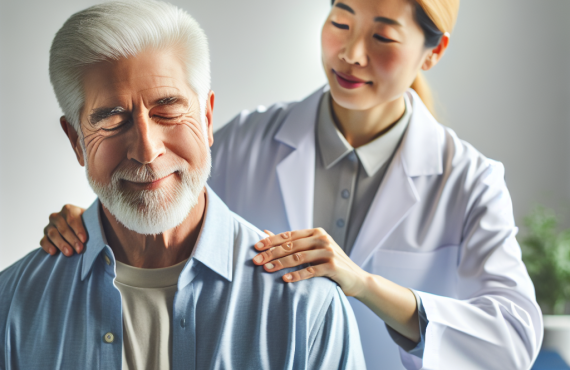If you’ve ever considered chiropractic care as a means to improve your overall health and wellness, you may be surprised to learn that it can also have a positive impact on your vision. At Henry Chiropractic, led by Dr. Craig Henry and Dr. Aaron Hixon, the focus goes beyond treating back or neck pain; their goal is to improve every aspect of their patients’ lives. With a variety of chiropractic techniques and a dedication to helping others, Dr. Hixon and Dr. Henry have the knowledge and experience to not only alleviate pain but also improve vision health. So, if you’re looking for a holistic approach to enhancing your vision, look no further than Henry Chiropractic in Pensacola, FL.

Table of Contents
Understanding Vision Health and Chiropractic Care
Vision health is an essential aspect of our overall well-being, but many people overlook the connection between chiropractic care and maintaining optimal vision. Chiropractic care focuses on ensuring the proper alignment and functioning of the spine and nervous system, which plays a crucial role in our body’s ability to perceive and interpret visual information.
Concept of Chiropractic Care
Chiropractic care is a natural healthcare approach that emphasizes the relationship between the spine and the nervous system. The central nervous system, comprised of the brain and spinal cord, controls and coordinates the various functions of the body, including vision. When there is a misalignment in the spine, known as a subluxation, it can disrupt the flow of information within the nervous system and affect different aspects of our health, including vision.
By using manual adjustments or targeted techniques, chiropractors aim to correct subluxations and restore proper alignment to the spine, allowing the nervous system to function optimally. This holistic approach to healthcare not only addresses symptoms but also promotes a balanced and healthy body.
Impact of Chiropractic Care on Overall Health
Chiropractic care goes beyond simply alleviating pain or discomfort. By restoring the body’s natural ability to heal and function, it can have a profound impact on our overall health. When the spine is properly aligned, the nervous system can communicate effectively with all parts of the body, including the eyes and visual pathways. This improved communication can enhance the body’s natural ability to maintain healthy vision.
Relation Between Chiropractic Care and Vision Health
The connection between chiropractic care and vision health lies in the intricate relationship between the nervous system and the eyes. The eyes, along with the optic nerves and visual pathways, rely on the transmission of electrical signals from the brain to function optimally. Any disruption or interference in this communication can lead to various vision problems.
Chiropractic care aims to remove these interferences by correcting subluxations in the spine. When the spine is properly aligned, the nervous system can send and receive signals efficiently, optimizing the visual processes. As a result, chiropractic care may play a vital role in improving and maintaining vision health.
Chiropractic and Eye Conditions
In addition to promoting overall vision health, chiropractic care can provide specific benefits for those suffering from certain eye conditions. Let’s explore some of the eye conditions that can be addressed through chiropractic treatments.
Chiropractic Care for Eye Strain and Fatigue
In today’s digital age, many individuals spend prolonged hours in front of screens, leading to eye strain and fatigue. This prolonged near-point visual stress can cause tension in the muscles of the neck and face, leading to discomfort and visual disturbances.
Chiropractic care can help relieve this strain by addressing the underlying musculoskeletal issues. Through spinal adjustments and soft tissue mobilization techniques, chiropractors can release tension in the neck and facial muscles, reducing eye strain and fatigue. Additionally, chiropractic care can promote proper posture, which can further alleviate these symptoms.
Chiropractic Treatments for Dry Eyes
Dry eyes can be a result of reduced tear production or an imbalance in tear composition, leading to discomfort and blurred vision. While there are various causes for dry eyes, misalignment in the cervical spine can contribute to the problem.
Chiropractic care can provide relief by realigning the spine and increasing blood flow to the eyes. This improved blood flow can enhance tear production and provide a natural remedy for dry eyes. Combined with lifestyle adjustments such as proper hydration and eye exercises, chiropractic care can contribute to long-term relief from dry eyes.
Addressing Headaches and Migraines that Affect Vision Through Chiropractic
Headaches and migraines can often manifest with visual disturbances, such as blurred vision, light sensitivity, and even temporary vision loss. These symptoms can be debilitating and significantly impact quality of life. Chiropractic care offers a drug-free and holistic approach to addressing headaches and migraines that affect vision.
By identifying and correcting subluxations in the cervical spine, chiropractors can alleviate the tension and nerve irritation contributing to headaches. Through spinal adjustments, soft tissue mobilization, and other chiropractic techniques, the underlying causes of headaches and migraines can be addressed, leading to reduced frequency and intensity of visual disturbances.
Role of Nervous System in Vision Health
To understand how chiropractic care can improve vision health, it’s essential to recognize the crucial role of the nervous system in visual function. The eyes capture visual information, but it is the nervous system that allows us to process and interpret this information accurately.
Nervous System and Vision Connections
The optic nerves, which transmit visual signals from the eyes to the brain, are an integral part of the nervous system. These nerves rely on the proper functioning of the spinal cord and brain to transmit and interpret visual information accurately.
Misalignments in the spine can impede the transmission of these signals, leading to visual disturbances. Chiropractic care focuses on aligning the spine and removing any interference in the nervous system, ensuring proper communication between the eyes, brain, and visual pathways.
Effects of Spinal Manipulation on Nervous System
Spinal manipulation, a primary technique used in chiropractic care, involves applying controlled force to specific areas of the spine. This manipulation aims to restore proper alignment, relieving pressure on the nervous system and reducing inflammation in the surrounding tissues.
By correcting subluxations, spinal manipulation enhances nerve function, allowing the nervous system to process visual information effectively. This improved communication can result in clearer vision and better overall visual health.
Potential Vision Improvements Through Enhanced Nervous System Function
When the nervous system functions optimally, it can enhance several aspects of vision, including visual acuity, depth perception, and eye coordination. By restoring alignment to the spine and promoting proper nervous system function, chiropractic care has the potential to improve these visual abilities.
Furthermore, optimal nervous system function can also support overall eye health, reducing the risk of age-related vision problems such as macular degeneration and glaucoma. Proper nervous system function is vital for maintaining healthy vision throughout life.
Scientific Evidence on Chiropractic Care and Vision Health
As chiropractic care continues to gain recognition, several scientific studies have explored its impact on vision health. Let’s delve into the scientific evidence supporting the connection between chiropractic care and vision.
Scientific Studies on Chiropractic Care and Vision
Research has shown promising results regarding the role of chiropractic care in improving vision health. A study published in the Journal of Manipulative and Physiological Therapeutics found that patients with visual field dysfunction experienced significant improvements after chiropractic treatment, suggesting a potential benefit for those with vision impairments.
Another study published in the Journal of Clinical Chiropractic Pediatrics demonstrated that chiropractic adjustments positively influenced patients with amblyopia, a condition commonly known as “lazy eye.” The study reported improvements in visual acuity and binocular vision among the participants, indicating the efficacy of chiropractic treatment for amblyopia.
Testimonials and Success Stories of Patients
In addition to scientific studies, numerous testimonials and success stories from patients highlight the positive impact of chiropractic care on vision health. Many individuals have reported improvements in their visual acuity, reduced eye strain, and relief from headaches and migraines affecting their vision after receiving chiropractic treatments.
While anecdotal evidence cannot replace scientific research, these personal experiences elucidate the potential benefits of chiropractic care in improving vision health and related conditions.
Debunking the Myths: Clarifying Misconceptions About Chiropractic and Vision Health
There are several misconceptions surrounding chiropractic care and its impact on vision health. Some individuals may believe that chiropractic adjustments can directly treat specific eye conditions, such as nearsightedness or astigmatism. However, chiropractic care does not target the eyes directly but rather focuses on improving overall nervous system function, which indirectly benefits vision health.
It’s important to understand that chiropractic care is not a substitute for optometric or ophthalmologic treatments. While chiropractic care can complement traditional vision care, it is essential to consult with both a chiropractor and eye care professionals for a comprehensive approach to vision health.

Chiropractic Techniques and Vision Health
Chiropractic care encompasses various techniques that can be applied to improve vision health. Let’s explore some of the commonly used techniques in chiropractic care and their potential benefits for vision.
Diversified Technique
The Diversified Technique is one of the most widely used chiropractic techniques. It involves applying manual thrusts to specific areas of the spine to correct subluxations and restore alignment. This technique can help relieve tension in the neck and upper back, promoting proper nervous system function and potentially improving visual processing.
Gonstead Spinal Manipulation
The Gonstead Technique focuses on careful analysis and specific adjustments to resolve spinal misalignments. By addressing specific problem areas, this technique aims to optimize nervous system communication throughout the body, including the visual pathways.
Instrument Assisted Soft Tissue Mobilization (IASTM)
IASTM involves using specialized tools to apply controlled pressure to soft tissues, such as muscles and ligaments, to address scar tissue, inflammation, and adhesions. This technique can help reduce muscle tension and improve blood flow, potentially benefiting eye muscles and promoting healthy vision.
Myofascial Release Technique (MRT)
MRT is a hands-on technique that targets the myofascial system, which encompasses muscles, ligaments, and connective tissues. By applying sustained pressure and stretching techniques, MRT can alleviate tension and improve mobility in the muscles surrounding the spine and neck, aiding in overall nervous system function and potentially benefiting vision health.
Regular Chiropractic Care for Better Vision Health
While chiropractic care can provide immediate relief for certain vision-related conditions, regular chiropractic treatments are crucial for maintaining long-term vision health. Here are some benefits of consistent chiropractic care:
Benefits of Consistent Chiropractic Treatments
Regular chiropractic treatments can contribute to better vision health by promoting proper spinal alignment, nervous system function, and overall well-being. By identifying and addressing subluxations before they lead to significant issues, consistent chiropractic care can help prevent potential vision problems and maintain optimal visual function.
Role of Chiropractors in Preventive Eye Health Care
Chiropractors can play a vital role in preventive eye health care by incorporating regular vision screenings and assessments into their practice. By recognizing signs of potential vision issues, chiropractors can refer patients to appropriate eye care professionals for further evaluation and treatment.
Chiropractic as a Complement to Traditional Vision Care
Chiropractic care is not meant to replace traditional vision care such as regular eye exams and corrective lenses. Instead, it can serve as a complementary approach to improve overall vision health. By addressing underlying musculoskeletal and nervous system issues, chiropractic care can enhance the effectiveness of traditional vision care methods and promote long-term visual wellness.
Dr. Craig Henry’s Approach to Vision Health
Dr. Craig Henry, the owner and operator of Henry Chiropractic in Pensacola, Florida, is dedicated to helping patients achieve optimal health and wellness, including vision health. With years of experience in chiropractic care, Dr. Henry employs a comprehensive approach to address the specific needs of each patient.
Profile of Dr. Craig Henry
Dr. Craig Henry is a licensed chiropractor serving Pensacola and the surrounding communities in Florida. With a passion for improving the lives of his patients, he has established a reputation for providing compassionate and effective care. Dr. Henry combines his expertise in chiropractic care with a deep understanding of vision health to offer personalized treatment plans tailored to each patient’s unique needs.
Dr. Craig Henry’s Methods in Chiropractic Vision Care
Dr. Henry’s approach to chiropractic vision care involves a thorough assessment of the spine, nervous system, and visual pathways. By identifying any misalignments or disruptions in communication, he develops targeted treatment plans that aim to restore alignment, promote proper nervous system function, and enhance visual processing. Dr. Henry employs a range of chiropractic techniques, including spinal adjustments, soft tissue mobilization, and lifestyle recommendations, to support patients in achieving their vision health goals.
Success Stories of Patients Under Dr. Craig Henry’s Care
Many patients under Dr. Craig Henry’s care have experienced significant improvements in their vision health. From reduced eye strain and fatigue to enhanced visual acuity and reduced frequency of migraines affecting vision, these success stories highlight the benefits of Dr. Henry’s approach to chiropractic vision care.
Dr. Aaron Hixon’s Work in Enhancing Vision Health
Dr. Aaron Hixon, another chiropractor at Henry Chiropractic, brings his expertise and dedication to enhancing vision health to the practice. With a genuine passion for helping others, Dr. Hixon combines his knowledge of chiropractic techniques with his commitment to patient-centered care.
Profile of Dr. Aaron Hixon
Dr. Aaron Hixon, a Florida native, is a licensed chiropractic physician and a board-certified chiropractor. Raised in Milton, FL, he received his Bachelor of Science in Exercise Science, followed by his chiropractic education at Palmer College of Chiropractic in Port Orange, FL. Dr. Hixon’s background in exercise science provides a comprehensive understanding of the musculoskeletal system and its impact on overall health, including vision health.
Dr. Aaron Hixon’s Chiropractic Techniques for Vision Improvement
Dr. Aaron Hixon specializes in various chiropractic techniques that can benefit vision health. Leveraging his training in Diversified, Gonstead Spinal Manipulation, Instrument Assisted Soft Tissue Mobilization (IASTM), Myofascial Release Technique (MRT), and more, he aims to address musculoskeletal imbalances that may affect the nervous system and impair visual function. Through personalized treatment plans, Dr. Hixon works closely with his patients to improve their vision health and overall well-being.
Success Stories of Patients Under Dr. Aaron Hixon’s Care
Dr. Aaron Hixon’s patients have witnessed tremendous improvements in their vision health under his care. Many patients have reported enhanced visual clarity, reduced eye strain, and relief from headaches that affect their vision. These success stories further exemplify the efficacy of Dr. Hixon’s chiropractic techniques in promoting vision health.
Safety and Risks of Chiropractic Care for Vision Health
Chiropractic care is generally safe and effective when performed by a licensed and experienced chiropractor. However, it’s important to understand the potential side effects, limits, and contraindications associated with chiropractic care for vision health.
Understanding Potential Side Effects
While rare, some individuals may experience mild side effects after chiropractic treatments, including temporary muscle soreness, headaches, or fatigue. These effects typically resolve on their own within a few days. It is essential to communicate any concerns or discomfort with the chiropractor to ensure that appropriate adjustments can be made to the treatment plan.
Identifying Limits and Contraindications
Chiropractic care may not be suitable for everyone, especially individuals with certain underlying medical conditions or anatomical abnormalities. Conditions such as osteoporosis, spinal cord compression, fractures, and certain vascular disorders may require modifications or contraindications for certain chiropractic techniques. It is vital to discuss any pre-existing medical conditions or concerns with a chiropractor to ensure safe and appropriate treatment.
Ensuring Safe and Effective Chiropractic Care for Vision
To ensure safe and effective chiropractic care for vision health, it is crucial to seek treatment from a licensed and experienced chiropractor. Chiropractors with specialized training and knowledge in vision health can offer personalized treatment plans tailored to individual needs. Additionally, open communication between the chiropractor and the patient is key to addressing any questions or concerns and ensuring a collaborative approach to care.
Future of Chiropractic Care in Vision Health
The future of chiropractic care in vision health holds promising advancements and increased awareness of its role in maintaining optimal visual wellness. Let’s explore some potential developments and collaborations that can shape the future of chiropractic care in vision health.
Potential Advancements in Chiropractic Care for Vision Health
Advancements in technology and research can further enhance the efficacy of chiropractic care for vision health. Continued scientific studies on the effects of chiropractic treatments on various eye conditions can help refine treatment protocols and develop evidence-based guidelines for optimizing vision health. Additionally, the integration of innovative techniques and modalities, such as advanced imaging and neurofeedback, can contribute to more targeted and effective chiropractic care for vision.
Increasing Awareness About Chiropractic’s Role in Vision Care
Educating the public about the connection between chiropractic care and vision health is essential for expanding its impact in this field. Increased awareness can lead to earlier interventions and preventive measures, addressing musculoskeletal and nervous system issues before they impact vision. By partnering with community organizations, optometrists, and ophthalmologists, chiropractors can collaborate to raise awareness and promote comprehensive vision care.
Fostering Collaborations with Optometrists and Ophthalmologists
Collaborations between chiropractors and eye care professionals can lead to a more holistic and integrated approach to vision care. By recognizing the value of each profession’s expertise, patients can receive well-rounded and comprehensive care that addresses both the underlying musculoskeletal issues and the specific vision-related concerns. These collaborative efforts can foster mutual referrals, shared knowledge, and a patient-centered approach to vision health.
In conclusion, chiropractic care has the potential to improve vision health by addressing musculoskeletal imbalances, optimizing nervous system function, and providing a holistic approach to well-being. Through techniques such as spinal manipulation, soft tissue mobilization, and lifestyle recommendations, chiropractors can support individuals in achieving and maintaining optimal vision health. As the field of chiropractic care continues to evolve, it is poised to play an increasingly important role in the future of vision care.






























































